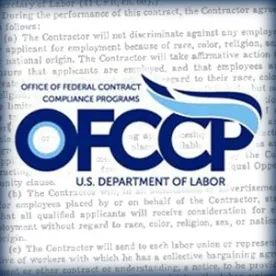OFCCP’s Pay Transparency regulations recently went into effect and with it came new information dissemination obligations for contractors with respect to job seekers. OFCCP recently held a webinar in which they discussed these obligations. In addition, the agency recently updated its website to include a section specifically addressing employer obligations surrounding posting of the Pay Transparency Non-Discrimination Provision.
The new pay transparency obligations are in addition to information posting obligations employers recently implemented in connection with the revised VEVRAA and Section 503 regulations.
With all of the recent changes, we thought this would be a good time to recap the items contractors should have on their Career webpages for viewing by job seekers.
-
EEO Tag Line
As a covered contractor, employers must inform job seekers that they will receive consideration for employment without regard to their “disability” or “protected veteran” status. At a minimum, the following is required. This language is also required to be present on job postings.
-
[COMPANY] is an EO employer – M/F/Vets/Disabled
-
[COMPANY] is an EO employer – Veterans/Disabled and other protected categories
It would also be permissible to post a more robust statement, such as the below:
Qualified applicants will receive consideration for employment without regard to race, color, religion, sex, national origin, sexual orientation, gender identity, disability or protected veteran status
-
Accessibility Statement
Contractors also need to provide individuals with disabilities who need assistance with the application process alternative means of contacting the company to obtain assistance. In compliance reviews, OFCCP expects to see two alternative methods for contacting the employer (e.g an e-mail address and a phone number). Companies also must ensure the e-mail inbox and voicemail for the phone number provided are monitored and inquiries are responded to promptly (ideally within 24 hours).
3. Link to EEO is the Law Poster
As part of the new VEVRAA and Section 503 obligations, the OFCCP’s “EEO is the Law”poster must be “conspicuously stored with, or as part of, the electronic application.” This obligation is to ensure applicants who apply for jobs electronically are informed of their equal employment opportunity protections as part of the application process.
OFCCP has clarified in an FAQ that the regulations do not require contractors to include a copy of the poster with every electronic application. As an acceptable alternative, OFCCP has said this obligation can be satisfied with a link on the career website to a copy of the poster with a brief explanation of what the link leads to. We recommend link to a .pdf of the poster instead of linking directly to OFCCP’s website.
-
Link to EEO is the Law Poster Supplement
In connection with the new VEVRAA and Section 503 regulations, as well as last year’s implementation of Executive Order 13672 providing protections on the basis of sexual orientation and gender identity and the recent finalization of the pay transparency regulations, OFCCP released a supplement to the EEO is the Law Poster. Until such time as OFCCP updates the EEO is the Law poster with language addressing these two areas, employers are required to post the provided supplement in addition to the EEO is the Law poster. This can be achieved in the same way discussed in Item 3 above.
-
Pay Transparency Non-Discrimination Statement
As discussed previously, employers must post for applicants to review a copy of the prescribed pay transparency nondiscrimination provision. As with the EEO is the Law and EEO is the Law supplement, this can be achieved with a link to a .pdf of the statement on an employer’s career website.
6. Link to EEO Policy Statement
While not required to be present on a career website, as a best practice employers should make available on their career webpages a copy of the Company’s EEO policy statement. This can be achieved as well with a link to a .pdf of the statement.
If an employer chooses not to post electronically, at a minimum the policy statement must be posted and viewable by applicants at the establishment where they are interviewed as part of the hiring process.




 />i
/>i

